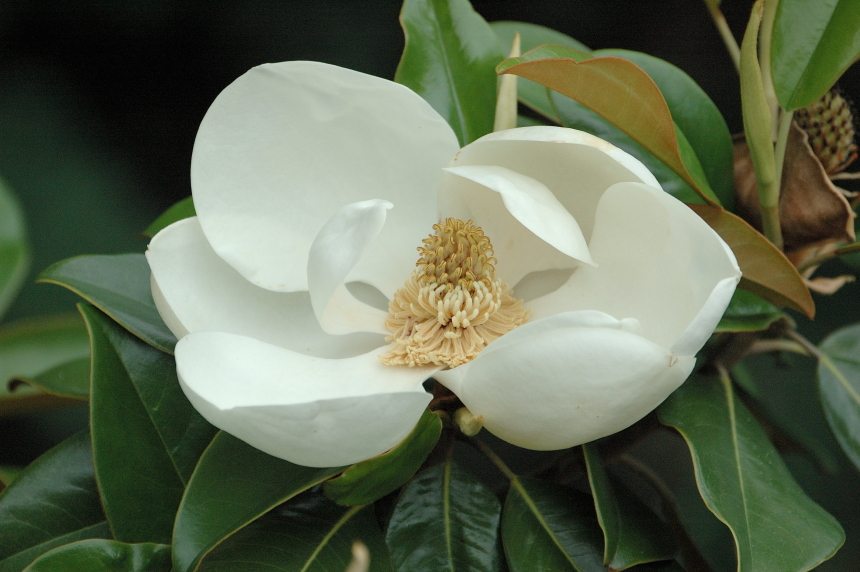
Southern Magnolia: The Quintessential Southern Tree
Grab an iced tea, a seat on the front porch and relax with the sweet fragrance of magnolia in the air. Now this is Southern living.
Southern magnolia (Magnolia grandiflora) is cherished for its glossy, dark green leaves, intoxicating scent and statuesque form. With its big, creamy white flowers, this tree provides a dazzling display in June, July and August.
Versatile and native trees, Southern magnolias are wonderful additions to any landscape. They can be used as specimen or screening trees and even as a hedge or espaliered on a wall or trellis. Magnolias are highly valued by floral designers, who use their lustrous leaves in floral arrangements.
Southern magnolias produce their best flowers in bright locations with at least three to five hours of sun per day. They can also be planted in areas with less sun, where you can enjoy the dark, glossy green foliage. We recommend that you plant the tree in a somewhat protected location sheltered from cold, winter wind that can lead to desiccation.
Planting your Southern magnolia
Spring and summer are the ideal times to plant Southern magnolias, so they have an entire growing season before the onset of winter. Dig a hole two to three times the diameter of—but no deeper than—the root ball. Mix a generous amount of Merrifield Planting Mix with the existing clay soil and use this blend to fill in around the roots. Southern magnolias don’t tolerate dry conditions, so it’s important to provide regular watering while they’re getting established and occasional watering during dry spells as they mature. Magnolias rarely have insect or disease problems.
For more information, read our planting guide or talk to one of our tree specialists.
Southern magnolias can become quite large, but it takes a long time. It is more common in our Virginia, Maryland and Washington, D.C., metropolitan area to see specimens that are 30’ to 40’ tall with a 20’ spread. You might want to plant your magnolia where leaf litter is hidden from view to make maintenance easier. It may be difficult to grow grass or plants under the tree’s canopy.
Growers have developed over 100 varieties of Southern magnolia.
Here are a few of the most hardy that we recommend for our area:
‘Alta’
This is a very narrow, upright form that is ideal for areas with limited space or for screening. ‘Alta’ is a slow growing variety with a mature height of about 20’ and a width of about 8.’ Its growth is very dense and compact with medium-dark green leaves and white, cup-shaped flowers.
‘Bracken’s Brown Beauty’
Prized for its dense, compact growth and cold hardiness, ‘Bracken’s Brown Beauty’ is a very popular variety. It will mature to a height of about 30’-40’ with a 15’-20’ spread. The leaves are a brilliant green on the upper surface and rusty brown on the underside.
‘D.D. Blanchard’
‘D.D. Blanchard,’ which boasts beautiful, dark green leaves with bright orange/brown undersides, is a hardy, classic beauty that matures to about 30’-40’ tall and 15’-20’ wide.
‘Edith Bogue’
Possibly the most cold hardy of all Southern magnolias, ‘Edith Bogue’ features creamy white flowers and light green leaves. It grows to a height of about 30’ and a width of 15.’
‘Little Gem’
An excellent choice where space is limited and for espalier training, ‘Little Gem’ grows to about 20’ tall and 12’ wide. The leaves and flowers are a bit smaller than other varieties, but they’re prolific and fragrant. The sweet-smelling flowers continue to open throughout the summer months.
‘Teddy Bear’
A very compact, upright tree that makes a great small specimen or accent in the landscape. Large, fragrant flowers cover the tree in the warm months. A reddish-brown felt can be seen underneath the shiny, deep green leaves.



